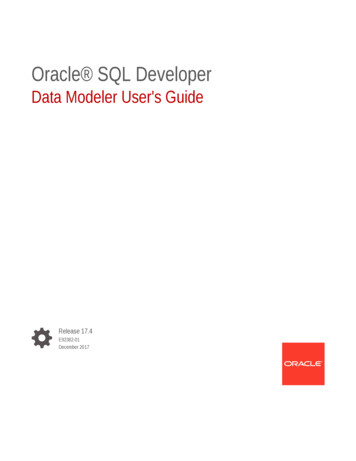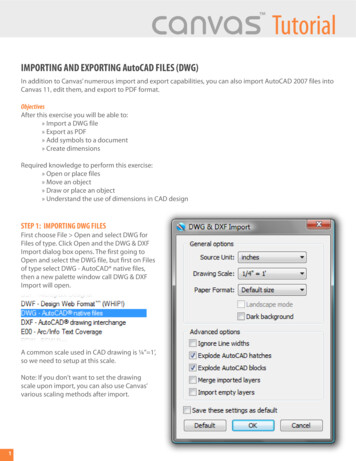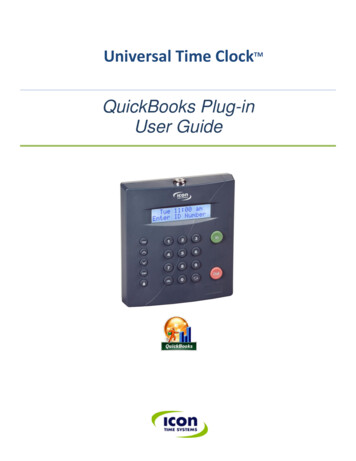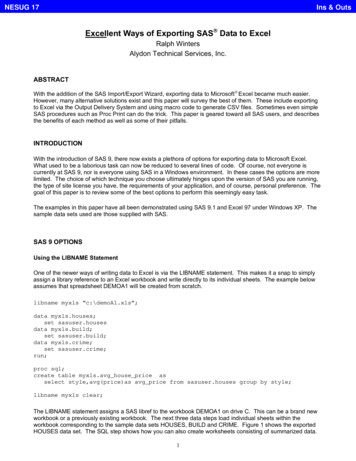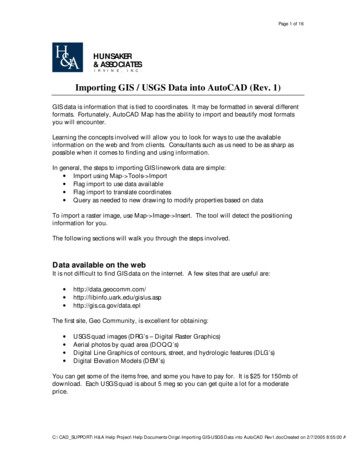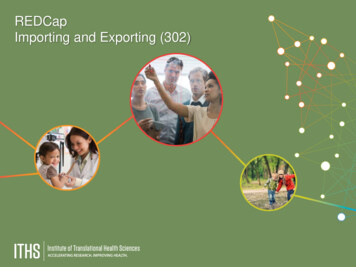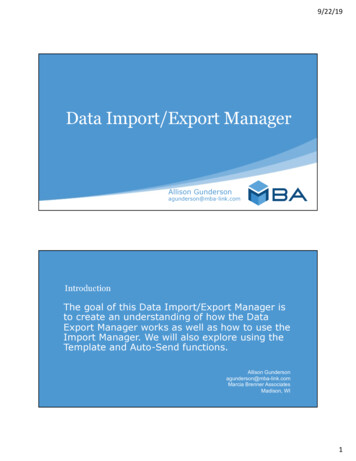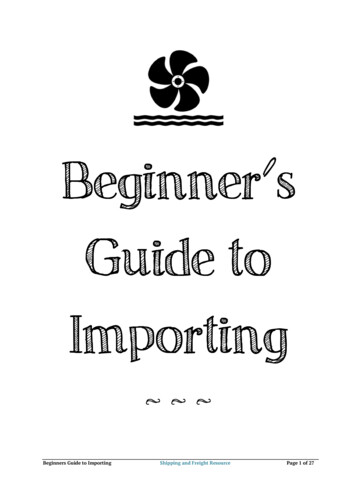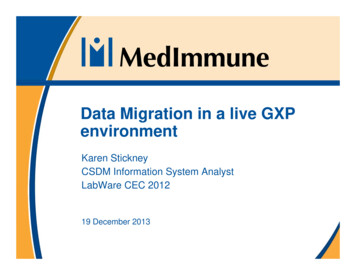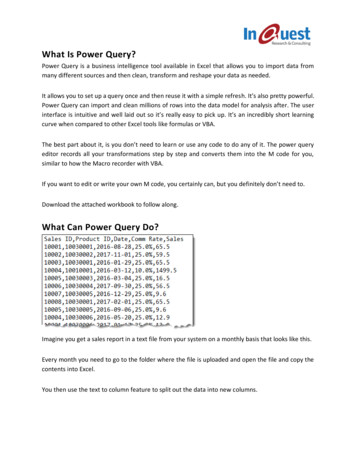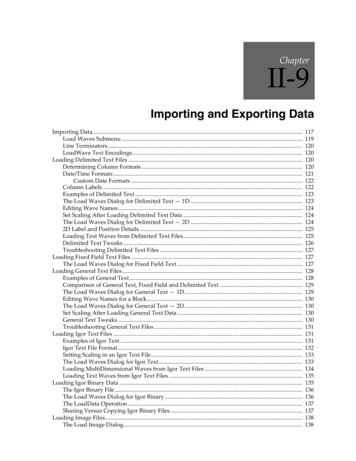
Transcription
ChapterII-9II-9Importing and Exporting DataImporting Data .Load Waves Submenu .Line Terminators.LoadWave Text Encodings.Loading Delimited Text Files .Determining Column Formats.Date/Time Formats .Custom Date Formats .Column Labels .Examples of Delimited Text .The Load Waves Dialog for Delimited Text — 1D .Editing Wave Names.Set Scaling After Loading Delimited Text Data .The Load Waves Dialog for Delimited Text — 2D .2D Label and Position Details .Loading Text Waves from Delimited Text Files.Delimited Text Tweaks .Troubleshooting Delimited Text Files .Loading Fixed Field Text Files .The Load Waves Dialog for Fixed Field Text .Loading General Text Files.Examples of General Text.Comparison of General Text, Fixed Field and Delimited Text .The Load Waves Dialog for General Text — 1D .Editing Wave Names for a Block.The Load Waves Dialog for General Text — 2D .Set Scaling After Loading General Text Data .General Text Tweaks .Troubleshooting General Text Files .Loading Igor Text Files .Examples of Igor Text .Igor Text File Format .Setting Scaling in an Igor Text File.The Load Waves Dialog for Igor Text.Loading MultiDimensional Waves from Igor Text Files .Loading Text Waves from Igor Text Files .Loading Igor Binary Data .The Igor Binary File .The Load Waves Dialog for Igor Binary.The LoadData Operation .Sharing Versus Copying Igor Binary Files.Loading Image Files.The Load Image 132133133134135135136136137137138138
Chapter II-9 — Importing and Exporting DataLoading PNG Files.Loading JPEG File.Loading BMP Files.Loading TIFF Files .Loading Sun Raster Files .Loading Row-Oriented Text Data .Loading HDF Files .Loading Excel Files .What XLLoadWave Loads.Column and Wave Types .Treat all columns as numeric .Treat all columns as date .Treat all columns as text .Deduce from row.Use column type string.XLLoadWave and Wave Names.XLLoadWave Output Variables .Excel Date/Time Versus Igor Date/Time .Loading Excel Data Into a 2D Wave .Loading Matlab MAT Files.Finding Matlab Dynamic Libraries .Matlab Dynamic Library Issues.Matlab Dynamic Library Issues on Macintosh.Matlab Dynamic Library Issues on Windows .Supported Matlab Data Types .Numeric Data Loading Modes .Loading General Binary Files.Files GBLoadWave Can Handle .GBLoadWave And Very Big Files .The Load General Binary Dialog .VAX Floating Point.Loading JCAMP Files .Files JCAMPLoadWave Can Handle .Loading JCAMP Header Information.Variables Set By JCAMPLoadWave .Using Header Variables From a Function.Loading GIS Data.Loading Sound Files .Loading Waves Using Igor Procedures .Variables Set by File Loaders .Loading and Graphing Waveform Data .Loading and Graphing XY Data .Loading All of the Files in a Folder.Exporting Data .Saving Waves in a Delimited Text File .Saving Waves in a General Text File.Saving Waves in an Igor Text File .Saving Waves in Igor Binary Files.Saving Waves in Image Files.Saving HDF Files .Saving GIS Files.Saving Sound Files.Exporting Text Waves .Exporting MultiDimensional Waves.Accessing SQL Databases 9159159159159160160160
Chapter II-9 — Importing and Exporting DataImporting DataMost Igor users create waves by loading data from a file created by another program. The process of loadinga file creates new waves and then stores data from the file in them. Optionally, you can overwrite existingwaves instead of creating new ones. The waves can be numeric or text and of dimension 1 through 4.Igor provides a number of different routines for loading data files. There is no single file format for numericor text data that all programs can read and write.There are two broad classes of files used for data interchange: text files and binary files. Text files are usually usedto exchange data between programs. Although they are called text files, they may contain numeric data, text dataor both. In any case, the data is encoded as plain text that you can read in a text editor. Binary files usually containdata that is efficiently encoded in a way that is unique to a single program and can not be viewed in a text editor.The closest thing to a universally accepted format for data interchange is the “delimited text” format. Thisconsists of rows and columns of numeric or text data with the rows separated by carriage return characters(CR - Macintosh), linefeed return characters (LF - Unix), or carriage return/linefeed (CRLF - Windows) andthe columns separated by tabs or commas. The tab or comma is called the “delimiter character”. The CR,LF, or CRLF characters are called the “terminator”. Igor can read delimited text files written by most programs.FORTRAN programs usually create fixed field text files in which a fixed number of bytes is used for eachcolumn of data with spaces as padding between columns. The Load Fixed Field Text routine is designed toread these files.Text files are convenient because you can create, inspect or edit them with any text editor. In Igor, you canuse a notebook window for this purpose. If you have data in a text file that has an unusual format, you mayneed to manually edit it before Igor can load it.Text files generated by scientific instruments or custom programs often have “header” information, usuallyat the start of the file. The header is not part of the block of data but contains information associated withit. Igor’s text loading routines are designed to load the block of data, not the header. The Load General Textroutine can usually automatically skip the header. The Load Delimited Text and Load Fixed Field Text routines needs to be told where the block of data starts if it is not at the start of the file.An advanced user could write an Igor procedure to read and parse information in the header using theOpen, FReadLine, StrSearch, sscanf and Close operations as well as Igor’s string manipulation capabilities.Igor includes an example experiment named Load File Demo which illustrates this.If you will be working on a Macintosh, and loading data from files on a PC, or vice-versa, you should lookat File System Issues on page III-400.The following table lists the data loading routines available in Igor and their salient features.File TypeDescriptionDelimited textCreated by spreadsheets, database programs, data acquisition programs, text editors,custom programs. This is the most commonly used format for exchanging data betweenprograms.Row Format: data delimiter data terminator Contains one block of data with any number of rows and columns. A row of columnlabels is optional.Can load numeric, text, date, time, and date/time columns.Can load columns into 1D waves or blocks into 2D waves.Columns may be equal or unequal in length.See Loading Delimited Text Files on page II-120.II-117
Chapter II-9 — Importing and Exporting DataFile TypeDescriptionFixed field textCreated by FORTRAN programs.Row Format: data padding data padding terminator Contains one block of data with any number of rows and columns.Each column consists of a fixed number of bytes including any space characters whichare used for padding.Can load numeric, text, date, time and date/time columns.Can load columns into 1D waves or blocks into 2D waves.Columns are usually equal in length but do not have to be.See Loading Fixed Field Text Files on page II-127.General textCreated by spreadsheets, database programs, data acquisition programs, text editors,custom programs.Row Format: number white space number terminator Contains one or more blocks of numbers with any number of rows and columns. A rowof column labels is optional.Can not handle columns containing non-numeric text, dates and times.Can load columns into 1D waves or blocks into 2D waves.Columns must be equal in length.Igor’s Load General Text routine has the ability to automatically skip nonnumericheader text.See Loading General Text Files on page II-128.Igor TextCreated by Igor, custom programs. Used mostly as a means to feed data and commandsfrom custom programs into Igor.Format: See Igor Text File Format on page II-132.Can load numeric and text data.Can load data into waves of dimension 1 through 4.Contains one or more wave blocks with any number of waves and rows.Consists of special Igor keywords, numbers and Igor commands.See Loading Igor Text Files on page II-131.Igor BinaryCreated by Igor, custom programs. Used by Igor to store wave data.Each file contains data for one Igor wave of dimension 1 through 4.Format: See Igor Technical Note #003, “Igor Binary Format”.See Loading Igor Binary Data on page II-135.ImageCreated by a wide variety of programs.Format: Always binary. Varies according to file type.Can load JPEG, PNG, TIFF, BMP, Sun Raster graphics files.Can load data into matrix waves, including TIFF image stacks.See Loading Image Files on page II-138.General binaryGeneral binary files are binary files created by other programs. If you understand thebinary file format, it is possible to load the data into Igor.See Loading General Binary Files on page II-146.II-118
Chapter II-9 — Importing and Exporting DataFile TypeDescriptionExcelSupports the .xls and .xlsx file formats.See Loading Excel Files on page II-140.HDF4Requires activating an Igor extension.See Loading HDF Files on page II-140.HDF5Requires activating the HDF5 package.See Loading HDF Files on page II-140.MatlabSee Loading Matlab MAT Files on page II-144.JCAMP-DXThe JCAMP-DX format is used primarily in infrared spectroscopy.See Loading JCAMP Files on page II-148.GISSupports a wide variety of GIS file formats including ESRI Shapefiles and GeoTIFF.Requires activating the IgorGIS package.See Loading GIS Data on page II-150.SoundSupports a variety of sound file formats.See Loading Sound Files on page II-150.TDMSLoads data from National Instruments TDMS files.Requires activating an extension.Supported on Windows only.See the “TDM Help.ihf” help file for details.Nicolet WFTLoads data written by old Nicolet oscilloscopes.Requires activating an extension.See the “NILoadWave Help.ihf” help file for details.SQL DatabasesLoads data from SQL databases.Requires activating an extension and expertise in database programming.See Accessing SQL Databases on page II-160.Load Waves SubmenuYou access all of these routines via the Load Waves submenu of the Data menu.The Load Waves item in this submenu leads to the Load Waves dialog. This dialog provides access to thebuilt-in routines for loading Igor binary files, Igor text files, delimited text files, general text files, and fixedfield text files, and provides access to all available options.The Load Igor Binary, Load Igor Text, Load General Text, and Load Delimited Text items in the Load Wavessubmenu are shortcuts that access the respective file loading routines with default options. We recommend thatyou start with the Load Waves item so that you can see what options are available.The precision of numeric waves created by Data Load General Text and Data Load Delimited Text is controlled by the Default Data Precision setting in the Data Loading section of the Miscellaneous Settings dialog.There are no shortcut items for loading fixed field text or image data because these formats require that youspecify certain parameters.The Load Image item leads to the Load Image dialog which provides the means to load various kinds ofimage files.II-119
Chapter II-9 — Importing and Exporting DataLine TerminatorsThe character or sequence of characters that marks the end of a line of text is known as the “line terminator”or “terminator” for short. Different computer systems use different terminator.Mac OS 9 used the carriage-return character (CR).Unix uses linefeed (LF).Windows uses a carriage-return and linefeed (CRLF) sequence.When loading waves, Igor treats a single CR, a single LF, or a CRLF as the end of a line. This allows Igor toload text data from file servers on a variety of computers without translation.LoadWave Text EncodingsThis section applies to loading a text file using Load General Text, Load Delimited Text, Load Fixed FieldText, or Load Igor Text.If your file uses a byte-oriented text encoding (i.e., a text encoding other than UTF-16 or UTF-32), and if thefile contains just numbers or just ASCII text, then you don’t need to be concerned with text encodings.If your file uses UTF-16, UTF-32, or contains non-ASCII text, you may neeed to tell the LoadWave operationwhich text encoding the file uses. For details, see LoadWave Text Encoding Issues on page V-453.Loading Delimited Text FilesA delimited text file consists of rows of values separated by tabs or commas with a carriage return, linefeed orcarriage return/linefeed sequence at the end of the row. There may optionally be a row of column labels. Igor canload each column in the file into a separate 1D wave or it can load all of the columns into a single 2D wave. Thereis no limit to the number of rows or columns except that all of the data must fit in available memory.In addition to numbers and text, the delimited text file may contain dates, times or date/times. The LoadDelimited Text routine attempts to automatically determine which of these formats is appropriate for eachcolumn in the file. You can override this automatic determination if necessary.A numeric column can contain, in addition to numbers, NaN and [ ]INF. NaN means “Not a Number” and isthe way Igor represents a blank or missing value in a numeric column. INF means “infinity”. If Igor finds text ina numeric or date/time column that it can’t interpret according to the format for that column, it treats it as a NaN.If Igor encounters, in any column, a delimiter with no data characters preceding it (i.e., two tabs in a row)it takes this as a missing value and stores a blank in the wave. In a numeric wave, a blank is represented bya NaN. In a text wave, it is represented by an element with zero characters in it.Determining Column FormatsThe Load Delimited Text routine must determine the format of each column of data to be loaded. Theformat for a given column can be numeric, date, time, date/time, or text. Text columns are loaded into textwaves while the other types are loaded into numeric waves with dates being represented as the number ofseconds since 1904-01-01.There are four methods for determining column formats: Auto-identify column type Treat all columns as numeric Treat all columns as text Use the LoadWave /B flag to explicitly specify the format of each columnII-120
Chapter II-9 — Importing and Exporting DataYou can choose from the first three of these methods using the Column Types pop-up menu in the Tweakssubdialog of the Load Waves dialog. To use the /B flag, you must manually add the flag to a LoadWavecommand. This is usually done in a procedure.In the “auto-identify column type” method, Igor attempts to determine the format of each column by examining the file. This is the default method when you choose Data Load Waves Load Delimited Text. Igorlooks for the first non-blank value in each column and makes a determination based on the column’s content. In most cases, the auto-identify method works and there is no need for the other methods.In the “treat all columns as numeric” method, Igor loads all columns into numeric waves. If some of thedata is not numeric, you get NaNs in the output wave. For backward compatibility, this is the defaultmethod when you use the LoadWave/J operation from the command line or from an Igor procedure. To usethe “auto-identify column type” method, you need to use LoadWave/J/K 0.In the “treat all columns as text” method, Igor loads all columns into text waves. This method may have usein rare cases in which you want to do text-processing on a file by loading it into a text wave and then usingIgor’s string manipulation capabilities to massage it.For details on the /B method, see the section Specifying Characteristics of Individual Columns on pageV-450.Date/Time FormatsThe Load Delimited Text routine can handle dates in many formats. A few “standard” formats are supported and in addition, you can specify a “custom” format (see Custom Date Formats on page II-122).The standard date formats /yy(day/month/year)To use the dd/mm/yy format instead of mm/dd/yy, you must set a tweak. See Delimited Text Tweaks onpage II-126.You can also use a dash or a dot as a separator instead of a slash.Igor can also handle times in the following forms:[ ][-]hh:mm:ss [AM PM](hours, minutes, seconds)[ ][-]hh:mm:ss.ff [AM PM](hours, minutes, seconds, fractions of seconds)[ ][-]hh:mm [AM PM](hours, minutes)[ ][-]hhhh:mm:ss.ff(hours, minutes, seconds, fractions of seconds)As of Igor Pro 6.23, Igor also accepts a colon instead of a dot before the fractional seconds.The first three forms are time-of-day forms. The last one is the elapsed time. In an elapsed time, the hour isin the range 0 to 9999.The year can be specified using two digits (99) or four digits (1999). If a two digit year is in the range 00 39, Igor treats this as 2000 2039. If a two digit year is in the range 40 99, Igor treats this as 1940 1999.The Load Delimited Text routine can also handle date/times which consist of one of these date formats, asingle space or the letter T, and then one of the time formats. To load date space time as a date/timevalue, space must not be specified as a delimiter character.II-121
Chapter II-9 — Importing and Exporting DataCustom Date FormatsIf your data file contains dates in a format other than the “standard” format, you can use Load DelimitedText to specify exactly what date format to use. You do this using the Delimited Text Tweaks dialog whichyou access through the Tweaks button in the Load Waves dialog. Choose Other from the Date Format popup menu. This leads to the Date Format dialog.By clicking the Use Common Format radio button, you can choose from a pop-up menu of common formats. After choosing a common format, you can still control minor properties of the format, such aswhether to use 2 or 4 digits years and whether to use leading zeros or not.In the rare case that your file’s date format does not match one of the common formats, you can use a fullcustom format by clicking the Use Custom Format radio button. It is best to first choose the common formatthat is closest to your format and then click the Use Custom Format button. Then you can make minorchanges to arrive at your final format.When you use either a common format or a full custom format, the format that you specify must match thedate in your file exactly.When loading data as delimited text, if you use a date format containing a comma, such as “October 11,1999”, you must make sure that LoadWave operation does not treat the comma as a delimiter. You can dothis using the Delimited Text Tweaks dialog.When loading a date format that consists entirely of digits, such as 991011, you should use the LoadWave/Bflag to specify that the data is a date. Otherwise, LoadWave will
Matlab See Loading Matlab MAT Files on page II-144. JCAMP-DX The JCAMP-DX format is used primarily in infra
